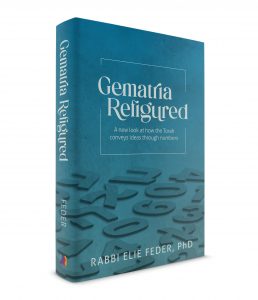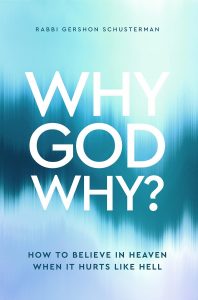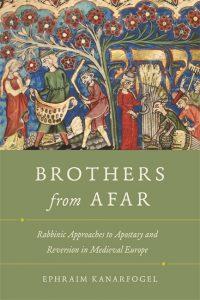Reviews in Brief – Spring 2023
Gematria Refigured: A New Look at How the Torah Conveys Ideas Through Numbers
Gematria is the calculation of the numerical equivalent of Hebrew words by assigning numbers to Hebrew letters. The casual student of Torah will occasionally come across gematria interpretations that make connections between numerically equivalent words. Often, these interpretations catch our attention and stick with us because of their clever creation of meaning through letters and numbers. But do they make sense?
Because Rabbi Elie Feder is a professor of mathematics, people assume he must enjoy a good gematria. After all, so many people who do not like numbers find gematriot pleasing. Certainly someone with a love for numbers must also love number-driven Torah interpretations. Yet, to the contrary, Rabbi Feder, who is also a maggid shiur at a Queens yeshivah, initially found many gematriot to be farfetched and unconvincing. He was a self-described gematria skeptic. And then he had an insight, an original understanding of how a good gematria builds on textual cues and explains specific difficulties.
The essence of Rabbi Feder’s theory is that a gematria converts a word into a number in order to direct the reader’s attention to an issue related to quantity. For example, the Torah (Bereishit 24:1) says that G-d blessed Avraham with “everything” (bakol). Rashi explains that the numerical equivalent of “bakol” is “ben,” which means “son.” Therefore, this verse means that G-d blessed Avraham with a son. Rabbi Feder points out that it is ludicrous to read the verse as meaning that G-d blessed Avraham with literally everything. That would mean an infinite showering of material and spiritual gifts. Rather, the one thing that Avraham wanted most was a son. Rashi (Bereishit 15:3) describes Avraham as saying to G-d, “Behold You have not given me a child—what benefit is everything that You give me?” Without someone to carry on his legacy, Avraham felt that he had nothing. Instead, Rashi and the Sages teach us that G-d blessed Avraham with something specific that to him was equivalent to everything, namely a son. They teach this with a gematria to shine a light on the quantitative aspect of this insight.
Rabbi Feder continues to explain a number of other gematria interpretations in a similar fashion. Rashi (Shemot 32:4) says that the Golden Calf was made with 125 talents of gold, the gematria of the word “masechah” (molten) used in the text. The gematria method of teaching is used here in order to focus our attention on the enormity of the sin, which includes the huge quantity of gold used to build the idol—more than twice as much gold as was used in the entire Mishkan. The Torah (Bamidbar 6:5) says that a nazir “will be (yihyeh) holy.” The Mishnah (Nazir 5a) teaches that the standard length of a nazir vow is thirty days, based on the gematria of the word “yihyeh.” Rabbi Feder explains that the acceptance of a nazir vow requires growth in personal holiness over a period of time in which the restrictions are observed. The gematria teaches us to look not only at the qualitative aspect of the growth, but also the quantitative aspect.
More than a book explaining the gematria method, this is a story of a personal journey from gematria skeptic to gematria enthusiast. Rabbi Feder utilizes his ample commentarial skills to build a framework in which the gematriot operate. The reader might not find all of Rabbi Feder’s explanations convincing and might even question the overall approach. Regardless, Rabbi Feder’s decades-long effort to find the depth and sophistication of a seemingly simple commentarial method serves as an important lesson in faith, humility and commitment.
Why God Why? How to Believe in Heaven When It Hurts Like Hell
Jewish philosophical literature is filled with different answers to the classic question: “Why do bad things happen to good people?” Many people find any single answer or combination of answers convincing on an intellectual level. But if, G-d forbid, they face tragedy in their own lives, they might reassess their evaluation. Rabbi Gershon Schusterman, a Chabad rabbi in Southern California who led a day school for many years, had comforted mourners with many of the standard answers until he became the mourner, with the untimely passing of his thirty-six-year-old wife, a mother of eleven. Suddenly the emotional weight seemed much heavier than the traditional texts could bear.
In this thoughtful and eloquent book, written over the many decades since he faced that personal tragedy, Rabbi Schusterman takes readers through the different traditional Jewish answers to the theological problem of tragedy. He sensitively probes the answers, showing their strengths, and pointing out with moving stories when they fall short. A toddler dying; a young lady who becomes religious and then discovers she has a degenerative disease; a man fatally hit by a car while delivering matzah to the homebound. Can we explain why these tragedies happened? The philosophical literature contains answers, but they do not necessarily satisfy. Through introspection over his own personal tragedy and how it affected him, Rabbi Schusterman speaks person-to-person, as a peer, with someone suffering. Explanations that might feel trite coming from someone else—e.g., suffering makes you a better person—ring true when Rabbi Schusterman talks about his own hard journey.
In his Sha’ar HaGemul, Ramban explores various answers to the question of tragedy and ultimately ends with the conclusion that we cannot fully understand G-d’s ways. If so, asks Ramban, why bother exploring the different answers and approaches? Because there is value in trying to understand. Even the partial truths, the semi-answers, can comfort some who are suffering and satisfy some who have questions. We need not answer every question and tie up every loose end in order to provide value. Rabbi Schusterman similarly reaches the end of human understanding and concludes with G-d’s unfathomable ways, particularly regarding the Holocaust. However, by asking the difficult questions, he validates others with similar concerns. By exploring the different possible answers, he offers consolation and meaning to those who are searching. And by concluding that we can never fully understand G-d’s ways, he defers to faith without compromising his integrity.
More than a collection of answers for tragedy, this book is the story of a journey of overcoming personal tragedy. One does not primarily need answers; one needs faith. If answers strengthen your faith, if they resonate with you, then you can find them in Rabbi Schusterman’s skillful discussion. However, over decades of consoling mourners, Rabbi Schusterman has found that people need G-d more than they need answers. This book is about confronting G-d with your tragedy and working through your complex and conflicted feelings in an ongoing dialogue with the Master of our world.
Brothers From Afar: Rabbinic Approaches to Apostasy and Reversion in Medieval Europe
The way we treat those who leave our community reflects, to some degree, the hopes and fears we have for our future generations. Long a minority in hostile countries, the Jewish people have developed mechanisms for maintaining our continuity. The late historian Professor Jacob Katz brought to the attention of the scholarly world how Jews have acted toward and thought about Christians in the Medieval and Early Modern Era. In particular, he highlighted changes in how we deal with the problem of the apostate, that is, a Jew who leaves the Jewish community and joins another faith community. Do we erect a large fence against apostates to make it harder for people to leave, or do we maintain close, respectful relations to encourage them to return? Because the Talmud offers little direct guidance, later authorities had to rule based on established custom and analogy to other categories.
According to Professor Katz, the Ashkenazic community radically changed its approach at the onset of the Modern Era. Rashi set the tone for Medieval Ashkenazim by applying to apostates the Talmudic statement that a Jew who sins remains a Jew. There may have been some limitations on an apostate, but the general attitude among Ashkenazic rabbis of this time was to keep the fence low and treat apostates as wayward Jews, as “one of us,” even if living outside the community. A popular custom arose to require a returning apostate to immerse himself in a mikvah, but that was not required by rabbis. According to Professor Katz’s influential theory, when the Modern Era began in the sixteenth century, the Jewish community’s position in relation to the Christian community changed and rabbis began raising the fence. Apostates were treated more like gentiles with a Jewish heritage.
Rabbi Dr. Ephraim Kanarfogel, a professor of Jewish history, literature and law at the Bernard Revel Graduate School of Jewish Studies and Stern College for Women, revisits and revises this theory in his Brothers from Afar. A student of Professor Katz, Rabbi Kanarfogel respectfully argues that in Medieval France and Germany, the Tosafists explored the status of apostates and applied many restrictions to them. Rabbi Kanarfogel does this through amassing a dizzying array of Medieval sources that demonstrate the widespread engagement with this difficult issue. Studying the Tosafists requires expertise not only in the published editions of Tosafot and related literature but also in the vast stores of as-yet-unpublished manuscripts and the new volumes that are continually published from manuscripts. Rabbi Kanarfogel demonstrates from across these texts a very different picture of Medieval Ashkenazic attitudes toward apostates. For example, Rabbeinu Tam, Rabbi Yitzchak of Dampierre (the Ri) and Rabbi Eliezer of Metz (all from the twelfth century) allowed a Jew to lend money with interest to an apostate despite the prohibition of taking interest from a Jew. They permit this not just because an apostate does not act like a “brother,” but because he has a status similar to a gentile. The Ri confirmed the need for a returning apostate to immerse in a mikvah, and Rabbi Shimshon of Sens (the Rash) required an additional, more formal acceptance of the commandments on return.
Some Tosafists considered a returning apostate to be akin to a convert. Others compared him to someone in Talmudic times who wished to acquire the status of a chaver, a person who is acknowledged as being careful with the laws of purity and agricultural tithes in contrast to an am ha’aretz, who is not trusted on these issues. There is significant debate over the status of marriages and divorces involving apostates. The serious nature of marriage generally yields strict rulings, which makes any leniencies to disregard apostate marriages and divorces surprising. However, despite the general stringency in this area, we find Tosafists who are willing to allow for some leniency regarding these and the requirement for yibum (levirate marriage) and chalitzah.
As can be expected from Tosafists, their positions differ greatly based on nuanced arguments. The brief summary above of just a few of the issues can only serve as a hint to Rabbi Kanarfogel’s robust discussion. What emerges from this Tosafist tapestry is clear evidence that even Medieval Ashkenazim had halachic fences against apostates. On these issues, the Ashkenazic Modern Era flowed directly from its Medieval precedents, with the different authorities building on the traditions they received. We find that Professor Katz highlighted an important area of halachic history, which a student developed further, revising his teacher’s theories based on new evidence and analysis. Professor Katz asked the important questions that laid the groundwork for future study.
Rabbi Gil Student writes frequently on Jewish issues and runs Torahmusings.com. He is a member of the Jewish Action Editorial Board.



